In this blog, I will explain how Enterprise Asset Management (henceforth it’s called as “EAM”) is used to maintain Linear Assets like pipelines, railway lines, electric lines, gas line & many others. Details on required customizations, master data & others for maintaining linear assets are explained with example.
What is Linear Asset?
Linear assets are those whose size vary across locations & exact locations are spread across length. Linear assets are technical systems with a linear infrastructure whose condition and properties can vary from section to section (dynamic segmentation). This concept in SAP is called as Linear Asset Management (henceforth it’s called as “LAM”) & the same can be maintained or integrated with EAM.
These linear assets can be created in EAM application as technical objects (equipment or functional location) which helps in maintenance tasks by creating notification, maintenance order & measurement document. This enables you to monitor what condition your linear assets are in, identify where there is damage or a defect (using the start point, end point, and offset), and manage all types of maintenance tasks (planned, unplanned, and preventive).
Required master data:
- Equipment
- Functional Location
- Measuring point.
Switch Framework
The following Extensions and Business Functions should be activated (Transaction SFW5):
| Enterprise_Extensions | EA-PLM |
| Enterprise_Business_Function | LOG_EAM_CI_1 |
| LOG_EAM_SIMPLICITY | |
| LOG_EAM_LINEAR_1 |
Creation of Required Customizing Data (SPRO):
Functional location category creation:
New Functional Location category ‘L’ creation steps:
SPRO –> Plant Maintenance & Customer Service –> Master data in Plant Maintenance & Customer Service –> Technical Objects –> Functional Location –> Define category of Functional Location.
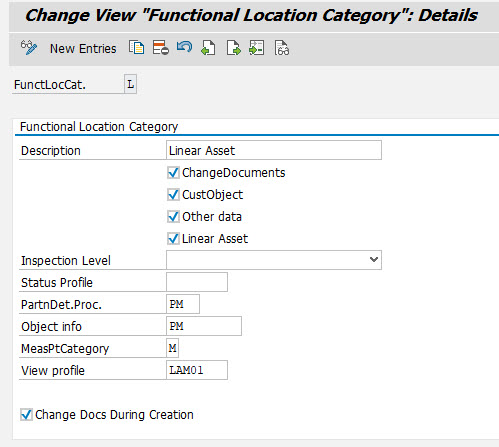
View profile LAM01 is created in SPRO –> Plant Maintenance & Customer Service –> Master data in Plant Maintenance & Customer Service –> Technical Objects –> General Data –> Set view profiles for Technical Objects.
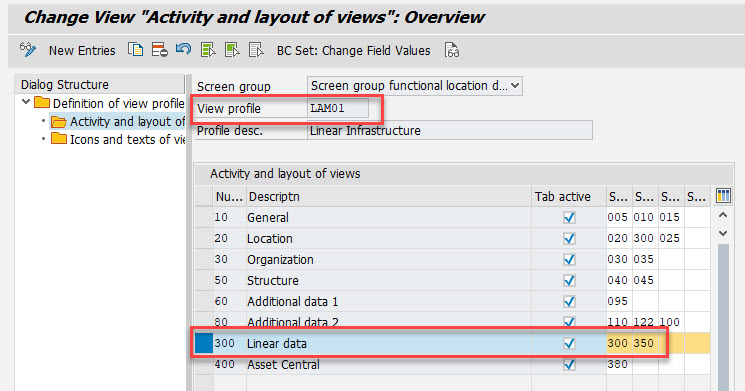
Equipment category creation:
SPRO –> Plant Maintenance & Customer Service –> Master data in Plant Maintenance & Customer Service –> Technical Objects –> Equipment –> Equipment Categories –> Maintain Equipment Category

View profile “LAM02” is defined in the same SPRO/configuration step: “Set view profiles for Technical Objects” with same values as LAM01.
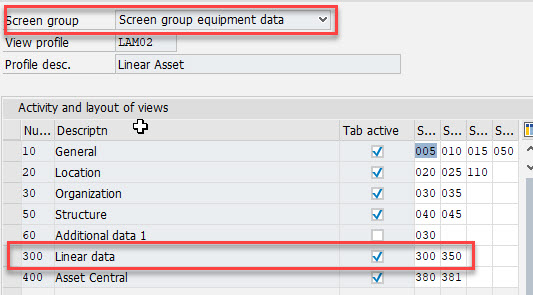
Measuring point category
This is only for the information. The scenario with measuring point & document are not used here.
SPRO –> Plant Maintenance and Customer Service –> Master Data in Plant Maintenance and Customer Service –> Basic Settings –> Measuring Points, Counters and Measurement Documents –> Define Measuring Point Categories
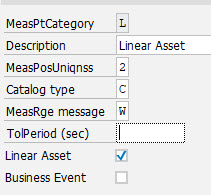
Define Offset Types:
SPRO –> Plant Maintenance & Customer Service –> Master data in Plant Maintenance & Customer Service –> Technical Objects –> Linear asset management –> Define offset types.
| Field Name | Offset Type 1 | Offset Type 2 |
|---|---|---|
| OTC | HZ | VT |
| Offset Type Description | Simple horizontal Offset | Simple vertical Offset |
| UoM | M | M |
| Default Offset | Not default for any offset | Not default for any offset |
| Documentation Offset | — | — |
Define Organizational Area
SPRO –> Cross-Application Components –> Classification System –> Classes –> Maintain Object Types and Class Types
| Field Name | Value | Value |
|---|---|---|
| Table | EQUI | IFLOT |
| Field Name | EQUI | IFLOT |
|---|---|---|
| Class | 002 | 003 |
| Organizational Area | L | L |
| Description Organizational Area | Linear Asset Management | Linear Asset Management |
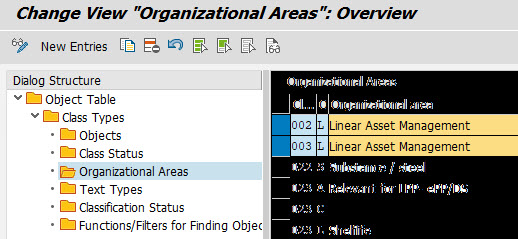
Define Organizational Area for Characteristics with Linear Data
SPRO –> Plant Maintenance and Customer Service –> Master Data in Plant Maintenance and Customer Service –> Basic Settings –> Linear Asset Management –> Define Organizational Area for Characteristics with Linear Data

Create Structure Indicator for Function Locations
TA: OIPK
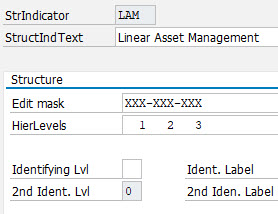
Create Characteristics
TA: CT04
| LAM_MATERIAL | LAM_THICKNESS | LAM_HEIGHT | |
|---|---|---|---|
| TAB: Basic Data | |||
| Basic data | |||
| Description | ###: LAM Material | ###: LAM Thickness | ###: LAM Height |
| Status | 1 | 1 | 1 |
| Format | |||
| Data Type | CHAR | NUM | NUM |
| Number of chars | 10 | 3 | 3 |
| Decimal places | – | 0 | 0 |
| Unit of Measure | – | mm | m |
| Value assignment | |||
| Multiple values | X | X | X |
| Entry required | – | – | – |
| TAB: Values | |||
| Char. Value | ASPHALT | 10 | – |
| Description | Asphalt | 10 mm | – |
| Char. Value | COBBLE | 15 | – |
| Description | Cobble | 15 mm | – |
| Char. Value | CONCRETE | – | – |
| Description | Concrete | – | – |

Create Equipment & Functional Location Classes. Assign characteristics.
TA: CL01
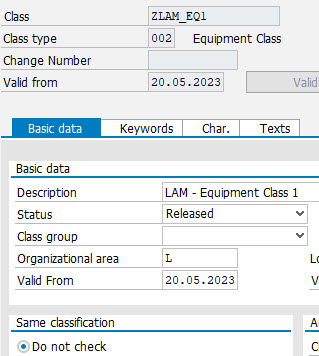

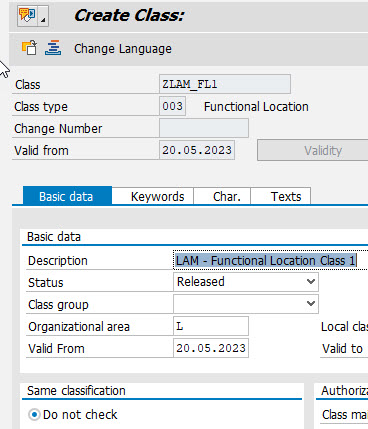
Master Data Creation
Equipment Creation
TA: IE01
The tab “linear data” will be activated & appear automictically when the equipment category is ‘L’.
Maintain values in the “linear data” tab screen for each characteristic (created in previous step) . Assign the created class “ZLAM_EQ1” to get all characteristic.
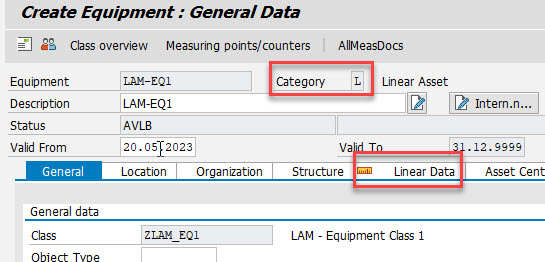
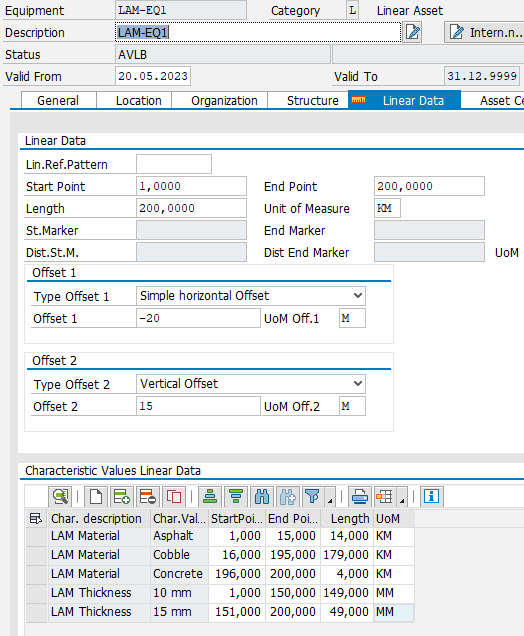
Functional Location Creation
TA: IL01

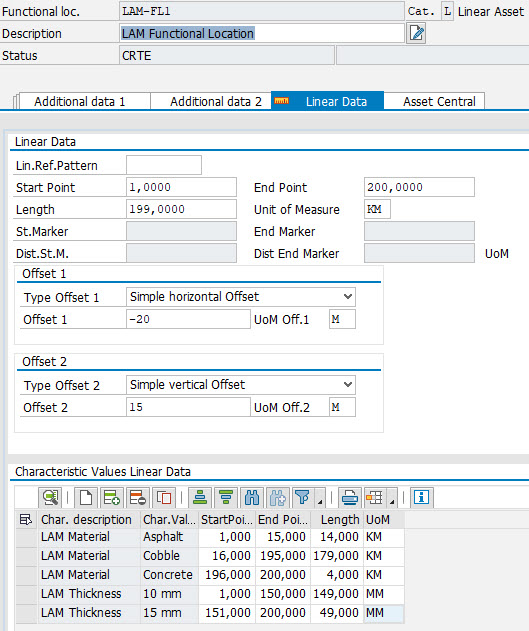
Working Example:
Notification creation for an Equipment
TA: IW21
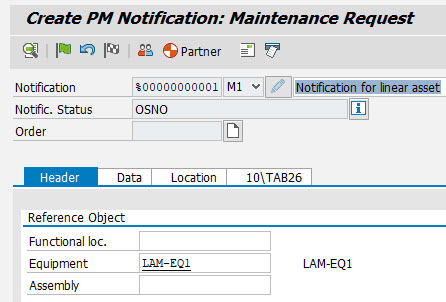
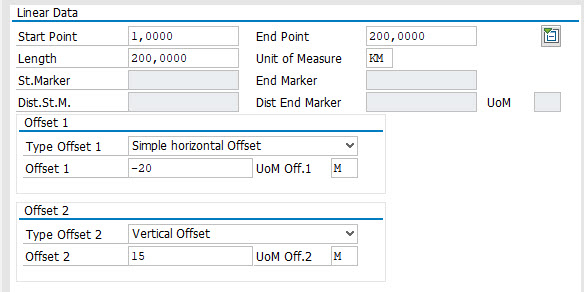
Linear data values will be populated automatically from the technical object & it can be edited to inform the technicians about the problem’s exact location.
Location or other tabs for notification can be added in SPRO –> Plant Maintenance & Customer Service –> Maintenance & Service Processing –> Maintenance & Service Notifications –> Notification Creation –> Notification Types –> Set screen templates for the notification type.
Maintenance Order creation for an Equipment
TA: IW31
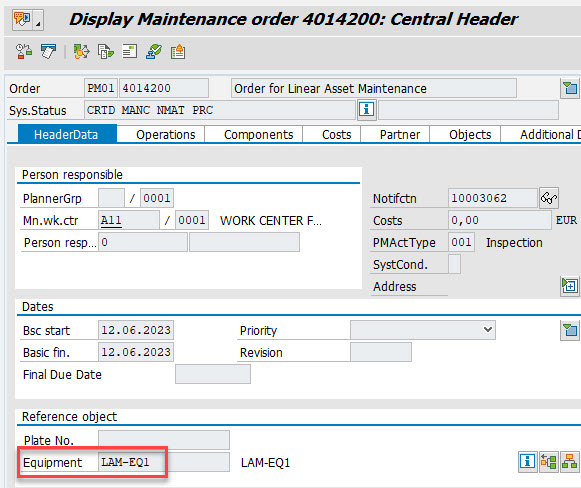
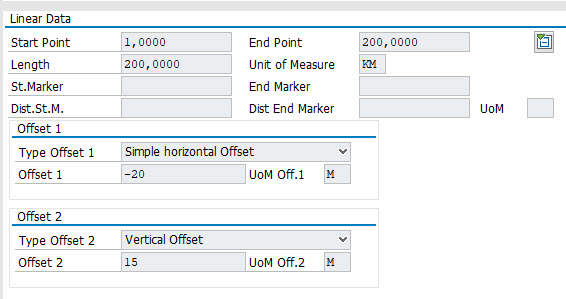
Other customizing steps which are required for LAM process but not shown here are:
- Creation of work center in TA: IR01
- Creation of number ranges
- Measuring points & documents – if required









